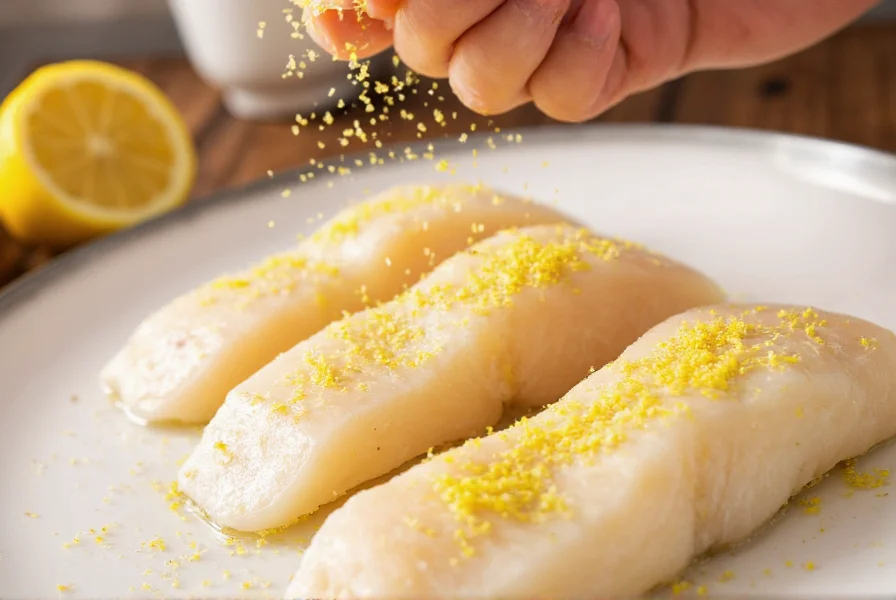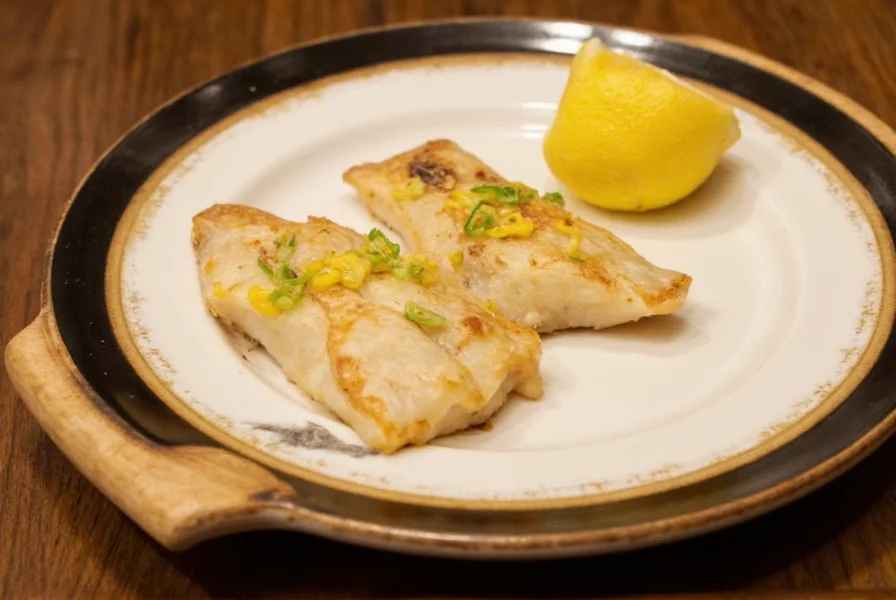Creating exceptional lemon pepper fish requires understanding the right fish selection, proper seasoning technique, and precise cooking methods. This versatile dish has become a staple in healthy cooking due to its simplicity and bold flavor profile that satisfies without heavy sauces or complicated steps. Whether you're a beginner cook or experienced chef, mastering this preparation opens doors to countless meal possibilities that work for weeknight dinners or special occasions.
Why Lemon Pepper Complements Fish Perfectly
The natural pairing of lemon and pepper with fish isn't accidental—it's culinary science. Lemon's acidity cuts through fish oils, enhancing freshness while neutralizing any potential fishiness. Black pepper adds subtle heat and complexity without overwhelming the delicate fish flavor. When combined properly, these elements create a seasoning blend that elevates rather than masks the natural taste of quality fish.
Choosing the Best Fish for Lemon Pepper Preparation
Not all fish respond equally well to lemon pepper seasoning. Understanding fish characteristics ensures optimal results:
| Fish Type | Texture | Lemon Pepper Compatibility | Recommended Cooking Method |
|---|---|---|---|
| Cod | Firm, flaky | Excellent | Baking, pan-searing |
| Halibut | Dense, meaty | Exceptional | Grilling, baking |
| Tilapia | Delicate, mild | Good | Pan-searing, baking |
| Salmon | Rich, oily | Moderate | Grilling (use lighter seasoning) |
Firm-textured fish like cod and halibut hold up best to lemon pepper seasoning without falling apart during cooking. Avoid overly oily fish unless you reduce the seasoning quantity, as stronger flavors can compete rather than complement.
Creating the Perfect Lemon Pepper Seasoning Blend
While store-bought lemon pepper seasoning works in a pinch, homemade blends deliver superior flavor. The ideal ratio balances citrus brightness with pepper's warmth:
- 2 tablespoons freshly grated lemon zest (never use bottled juice for seasoning)
- 1 tablespoon coarsely ground black pepper
- 1 teaspoon garlic powder
- 1 teaspoon onion powder
- ½ teaspoon sea salt
- ¼ teaspoon paprika (optional for color)
Mix these ingredients thoroughly and store in an airtight container for up to two weeks. The key to professional results with lemon pepper fish baking instructions is applying the seasoning properly—press it gently into the fish surface rather than just sprinkling on top.

Step-by-Step Preparation Guide for Perfect Results
Follow these professional techniques for restaurant-quality lemon pepper fish at home:
- Prepare the fish: Pat fillets completely dry with paper towels—moisture prevents proper searing
- Season properly: Apply olive oil first, then press seasoning blend evenly onto both sides
- Rest before cooking: Let seasoned fish sit 10-15 minutes at room temperature
- Cook to perfection: For pan seared lemon pepper fish, use medium-high heat with enough oil to coat the pan
- Monitor temperature: Cook until internal temperature reaches 145°F (63°C)
- Finish with fresh lemon: Squeeze fresh lemon juice over cooked fish just before serving
Three Cooking Methods Compared
Different cooking techniques yield distinct results with your lemon pepper fish recipe:
Baking Lemon Pepper Fish
Preheat oven to 400°F (200°C). Place seasoned fish on parchment-lined baking sheet. Bake 12-15 minutes depending on thickness. Baking produces evenly cooked fish with minimal hands-on time, making it ideal for easy lemon pepper fish preparation when multitasking.
Pan-Searing Lemon Pepper Fish
Heat 2 tablespoons oil in oven-safe skillet over medium-high heat. Cook fish 3-4 minutes per side until golden crust forms. Finish in oven if thick cuts. This method creates the most flavorful crust, perfect for those following lemon pepper fish pan searing techniques.

Grilling Lemon Pepper Fish
Preheat grill to medium-high. Oil grates thoroughly. Cook 4-5 minutes per side. Use a fish basket for delicate varieties. Grilling adds smoky notes that complement the lemon pepper seasoning for fish, especially with firmer fish like halibut.
Avoiding Common Lemon Pepper Fish Mistakes
Even experienced cooks make these errors when preparing healthy lemon pepper fish dinner options:
- Using bottled lemon juice in seasoning: Only fresh zest provides proper flavor concentration
- Overcrowding the pan: Causes steaming instead of searing—cook in batches if necessary
- Flipping too soon: Wait until fish releases naturally from the cooking surface
- Over-seasoning: Strong blends can overwhelm delicate fish—start with less, add more after cooking if needed
- Skipping the resting period: Essential for seasoning adherence and even cooking
Serving Suggestions for Complete Meals
Lemon pepper fish pairs beautifully with light, fresh accompaniments that complement rather than compete with its delicate flavor profile. Consider these pairings for your best lemon pepper fish recipe presentation:
- Roasted asparagus with garlic
- Quinoa pilaf with fresh herbs
- Caprese salad with balsamic reduction
- Steamed broccoli with lemon slices
- Wild rice with toasted almonds
For wine pairings, select crisp white varieties like Sauvignon Blanc or Pinot Grigio that match the dish's brightness without overwhelming the fish.
Storage and Reheating Guidelines
Proper storage maintains quality when enjoying leftovers of your lemon pepper fish preparation:
- Refrigerate within two hours of cooking in airtight container
- Consume within 2 days for optimal quality
- Reheat gently in oven at 275°F (135°C) until warmed through
- Avoid microwaving which makes fish rubbery
- Never refreeze previously frozen cooked fish
Frequently Asked Questions
What's the best fish for lemon pepper seasoning?
Firm white fish like cod, halibut, and sea bass work best with lemon pepper seasoning. These varieties have mild flavors that complement rather than compete with the citrus-pepper blend. Avoid overly oily fish like mackerel which can clash with the seasoning profile.
How long should I cook lemon pepper fish?
Cooking time depends on thickness and method. For 1-inch thick fillets: baking takes 12-15 minutes at 400°F, pan-searing requires 3-4 minutes per side, and grilling needs 4-5 minutes per side. Always cook until internal temperature reaches 145°F (63°C) for food safety.
Can I use dried lemon zest in my lemon pepper blend?
Freshly grated lemon zest delivers superior flavor compared to dried alternatives. Dried zest loses volatile oils that provide the bright citrus notes essential to proper lemon pepper seasoning. For best results with your lemon pepper fish recipe, always use fresh lemons and grate the zest immediately before mixing your seasoning blend.
Why does my lemon pepper fish stick to the pan?
Fish sticks when the cooking surface isn't hot enough or when you try to flip too soon. Proper technique for pan-seared lemon pepper fish requires heating oil until shimmering (not smoking), placing fish in the pan, and waiting until it releases naturally before attempting to flip—usually 3-4 minutes. Patting fish completely dry before seasoning also prevents sticking.











 浙公网安备
33010002000092号
浙公网安备
33010002000092号 浙B2-20120091-4
浙B2-20120091-4